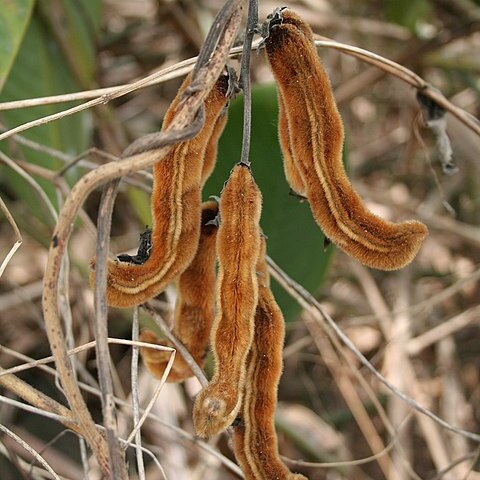A bean. It is a woody creeper with stem up to 30 m long. The stems can be 20 cm across. The sap stains things dark brown. The leaves are alternate and have leaflets along the stalk. The leaflets can be 10-19 cm long by 6-19 cm wide. The side leaflets are unequal. The flowers hang in a group in the axils of leaves. The flowers have orange-red hairs. The fruit is an oblong pod 5-20 cm long by 4 cm wide. It is covered with red bristles that irritate the skin. The pod contains 1-5 seeds. The seeds are curved and 2.5 cm long by 2 cm wide and flattened. They are purple with brown marks.
Leaflets 10–19 × 6–15.5(19) cm, rhombic, ovate or obovate, the laterals very asymmetrical, apiculate or rounded at the apex, rounded to subcordate at the base, sparsely appressed pubescent above, densely appressed silvery-grey hairy beneath or in some variants woolly or glabrescent save for hairs on the nerves; petiole 8–16 cm long; rhachis 1.5–3 cm long; petiolules 5–8 mm long; stipules c. 1 cm long, triangular.
Standard greenish-white or yellowish, 2.5–5 × 2.1–3.4 cm, ovate to elliptic, ± glabrous but sometimes with very sparse irritant bristles outside; wings and keel greenish-cream, sometimes with a tinge of purple along the edges, 4–9 cm long, apex of the beak curved and horny; staminal tube sometimes crimson.
Calyx densely velvety and with appressed orange-red bristly irritant hairs; tube 5–12 mm long, sometimes eventually attaining 2.3 cm in width; lobes oblong to linear, 2–7 mm long or lowest lobe up to 2.2 cm in some West African specimens, upper pair joined to form an obtuse bilobed lip.
Inflorescences pendulous, usually with numerous flowers; rhachis 6–32 cm long; peduncle 2–20 cm long, greyish or ferruginous tomentose; several flowers per node, the nodes up to 5 mm long; pedicels 0.8–1 cm long; bracteoles 10–16 × 4–6 mm, very deciduous.
Fruits when 1-seeded almost round, 5 cm long, 4 cm wide, but usually 2–5-seeded and 14–20 × 3.5–4 × 1.8 cm, not winged and probably indehiscent, densely covered with deciduous orange-brown or orange-red bristly very irritant hairs.
Seeds purple or pale brown with dense dark brown mottling, 25–26 × 15–20 × 8–9 mm, irregularly elliptic-oblong, curved, much compressed; hilum 15–16 × 3 mm; aril little developed, black.
Large liane, the stems attaining 20 cm in diameter and 10–30 m in height.
Stems glabrous or pubescent.

